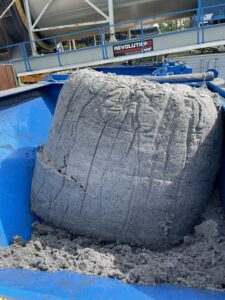Tire Fiber Helps Reduce Cracking in Asphalt
In September 2022, Liberty Tire Recycling teamed up with Michigan Technological University, and Ace-Saginaw Paving in the first of a kind project to beneficially reuse the tire fiber that was separated from passenger tire rubber during the granulating and tire recycling process.
The project, funded through a grant from the scrap tire program administered by the Michigan Department of Environment, Great Lakes, and Energy (EGLE), involved an overlay of county road with three different types of asphalt mix: standard asphalt mix; standard asphalt mix dosed with 0.6 percent SmartMIX rubber (12 lbs of SmartMIX/ton of asphalt mix) and a standard mix, with 0.6 percent SmartMIX plus 2.4 lbs of recycled tire fiber, 0.12% by weight of the mix.
SmartMIX (Sustainable Material with Asphalt Rubber Technologies) is a line of dry mix rubber additives for high-performance paved surfaces and is a next generation technology for rubberized asphalt. It uses proprietary technology to provide a pre-swelled, reacted rubber particle that can be easily incorporated into an asphalt mixture at the mix plant. The easy integration of SmartMIX doesn’t require an additional binder, elevated mixing temperatures, longer mixing times or lengthy storage times.
 A typical 20 pound passenger tire will yield 12 pounds of rubber, 7 pounds of steel, and 1 pound of fiber. This project used rubber from 1,715 scrap tires and fiber collected from 2,024 scrap tires. Manufactured fibers are commonly used in specialty asphalt mixtures and are manufactured to be one inch in length.
A typical 20 pound passenger tire will yield 12 pounds of rubber, 7 pounds of steel, and 1 pound of fiber. This project used rubber from 1,715 scrap tires and fiber collected from 2,024 scrap tires. Manufactured fibers are commonly used in specialty asphalt mixtures and are manufactured to be one inch in length.
This project evaluated the potential to use fibers derived from the tire recycling process. Tire fiber fluff is collected on shaker table screens at the recycling facility and lifted off via a vacuum system. It is typically collected and sent to various facilities that use the fiber as an alternative fuel source, augmenting other solid fuels. According to the U.S, Tire Manufacturers Association, tire fiber fluff is derived from various types of fabric cords that reinforce the tire. Tire fabric cords provide dimensional stability to the tire and help support the vehicle weight. These textiles are polyester cord fabrics, rayon cord fabric, nylon cord fabric, and aramid cord fabric. They are used to make the tire plies in passenger tires.
The individual pieces of fiber are very short in length as a result of tire processing. After rubber is run through a granulator, the fibers that are liberated are about 2 mm in length. However, the tire fibers collect and clump together like large cotton balls.
At the start of the project it was unknown if the tire fibers would separate sufficiently to disburse homogeneously in the asphalt mix. A fiber feeding machine built by Hi-Tech Asphalt Solutions that normally handles cellulose fiber was hooked up to Ace-Saginaw’s asphalt mix plant and a flexible hose was connected to their standard port designed to distribute the fiber into the asphalt mixing drum. A similar machine was used to add and disburse the SmartMIX Rubber powder, the flex hose from the blower was attached to the recycled asphalt chute so that the rubber powder blew into the recycled material stream as it entered the mixing drum.
The fiber machine was successful in the separation and distribution of the tire fiber into the mix. No conglomeration of fiber was observed at the paving site on any of the equipment or rakes used by the paving crew.
The mixtures from this project indicated a 35 percent improvement in resistance to crack energy propagation when SmartMIX was added to the regular mix. The inclusion of tire fiber provided an additional 8 percent improvement so that the tire fiber and SmartMIX combination would provide an overall 43 percent improvement in strengthening and reinforcing the mix against cracking.
© Scrap Tire News, August 2023






